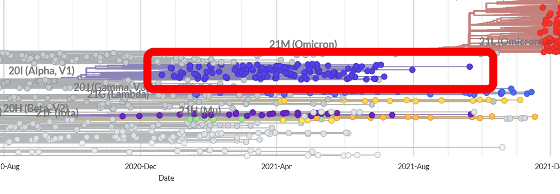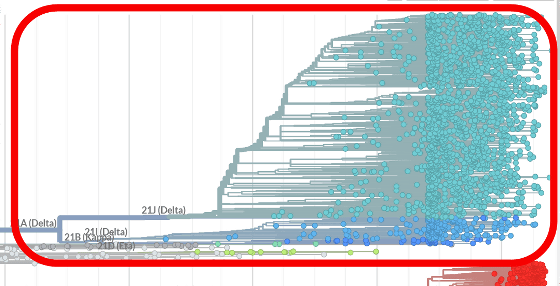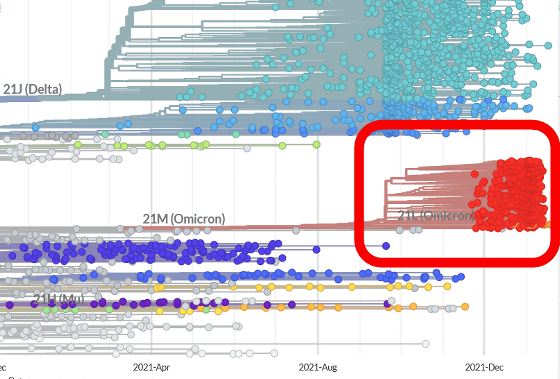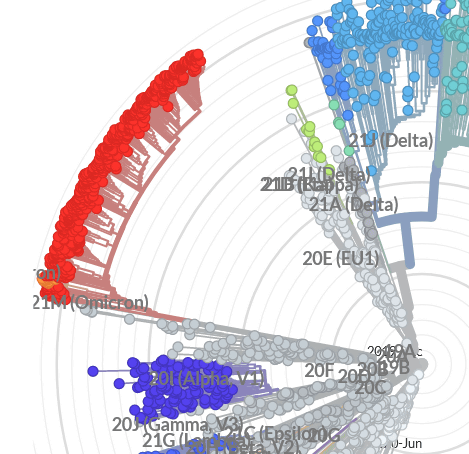Where are the variants of the new coronavirus born?

There are many 'variant strains' such as
Where do mutants come from? --Microbiology Nuts & Bolts
http://www.microbiologynutsandbolts.co.uk/the-bug-blog/where-do-mutants-come-from
The following figure introduced by Mr. Garner is the 'gene lineage tree of the new coronavirus ' published by Nextstrain, a project to track the spread of virus strains and mutations over time. Since the first virus was reported in 2019, we can see that a wide variety of viruses have been born.

For example, the blue circle that appeared in December 2020 indicates the alpha strain (blue) of the new coronavirus. The alpha strain is more infectious and more severe than the conventional strain, making it the most prevalent new coronavirus strain in the world.

Soon after that, the Delta strain (light blue) replaced it ...

At the time of writing the article, the Omicron strain (red) reported in November 2021 is the mainstream.

However, when viewed as a whole, it can be seen that most of the mutant strains have not become so prevalent, and only a few of them become dominant strains such as alpha strains, delta strains, and omicron strains.

In the figure below, also published by Nextstrain, the center of the circle shows the first discovered new coronavirus, from which the phylogenetic tree of the virus is extended in a circle. The longer the line extending from the outer circle indicating the virus strain to the center, the less the genetically similar mutant strains.

Looking at this, we can see that the Omicron strain (red) has a particularly low similarity to other mutant strains and appears to appear suddenly. Therefore, many researchers are worried about 'where did the Omicron strain occur?'

'The short and easy answer to this is'we don't know',' Garner said of where the Omicron strain originated, but he said he could make some guesses. Regarding the outbreak of Omicron strains, it is explained that the following three scenarios are possible.
◆ 1: Antigenic drift in the body of immunocompromised people
The new coronavirus has a stable genome, and gene mutation occurs very slowly due to
However, in immunocompromised people, the new coronavirus may continue to be infected for several months or more, in which case there is time to accumulate mutations in the body and generate new mutant strains due to antigen drift. increase. Most scientists suspect that mutant strains such as Alpha, Delta, and Omicron strains were born in immunocompromised patients and spread to others.

◆ Antigenic drift between mammals other than humans
On the other hand, even if the mutation is due to the same antigen drift, there may be a scenario in which 'antigenic drift has occurred between mammals other than humans.' In fact, it is known that the new coronavirus infects not only humans but also
A mutant of the new coronavirus infects humans from mink, killing 17 million minks-GIGAZINE

by dennisicecap1
Therefore, it has been pointed out that a mutant strain that suddenly appeared, such as the Omicron strain, may actually have been born between mammals other than humans. In January 2022, a Chinese research team published a paper claiming that 'Omicron strains were mutated from humans to mice infected with the new coronavirus and infected again with humans.' According to the research team, the gene sequence of the spike protein of the Omicron strain was similar to that of the mutant strain that evolved in the mouse cellular environment.
The origin of the new corona Omicron strain was found to be mutated in mice and infected humans --GIGAZINE

'There is no evidence to support the hypothesis that a mutant strain was born in an animal, but there is no evidence to rule out the hypothesis,' Garner said, arguing that there is no clear evidence but needs to be considered.
◆ 3: Antigenic shift in the body of a person who is not immunodeficient
The third scenario, Garner cites, is the possibility that 'the two viruses are mixed in the body of a person who is not immunocompromised.' A virus propagates in the cells of an organism, and at this time, the genes of two different viral strains are mixed to form a new mutant strain, which is called antigenic shift (antigenic shift). Antigenic shift is a common phenomenon in influenza virus, for example, the ' H1N5 ' virus is thought to be a mixture of 'H1N1 ' and ' H2N5'.
Antigenic shift has not been identified in the new coronavirus, and there are no candidates for the two strains on which the Omicron strain was based, Garner said, which is the least likely of the three scenarios.

After all, Garner says he doesn't know the answer to the problem, but 'I hope it's a scenario of antigen drift in an immunocompromised person.' If the mutant strain is occurring in the body of a long-term infected person, he claims that measures can be taken to prevent infection of high-risk people as much as possible and priority is given to vaccination. On the other hand, he said that if mutant strains that occurred in non-human animals have spread to humans, humans will either aim for coexistence with the new coronavirus or take some other measures.
Related Posts:
in Science, Posted by log1h_ik






